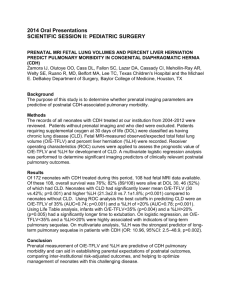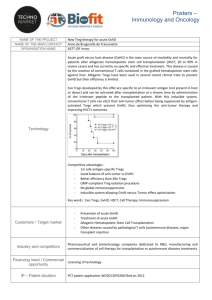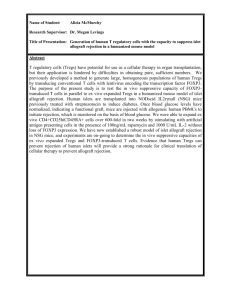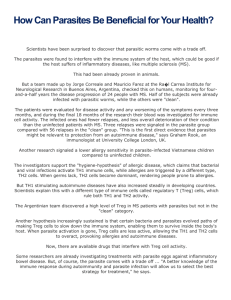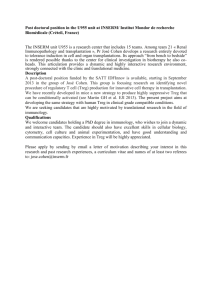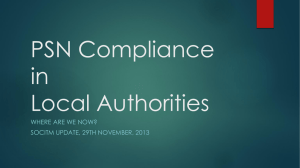Regulatory T cell adjustment of quorum growth
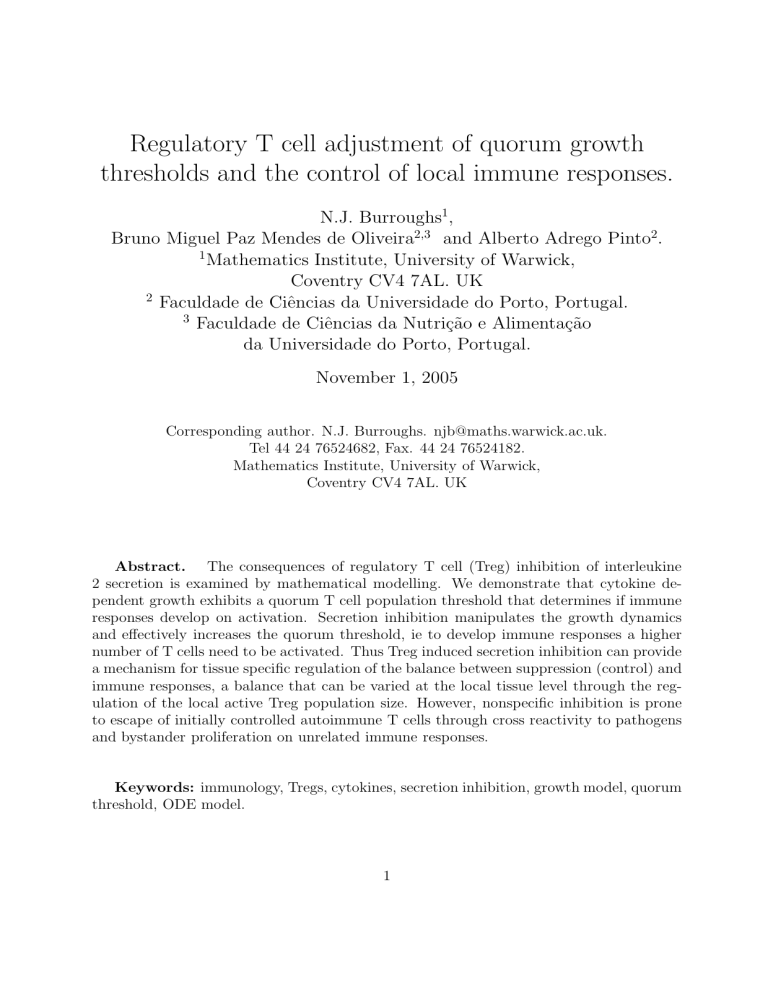
Regulatory T cell adjustment of quorum growth thresholds and the control of local immune responses.
N.J. Burroughs
1
,
Bruno Miguel Paz Mendes de Oliveira
2
,
3
and Alberto Adrego Pinto
2
.
1
Mathematics Institute, University of Warwick,
2
Coventry CV4 7AL. UK
Faculdade de Ciˆencias da Universidade do Porto, Portugal.
3
Faculdade de Ciˆencias da Nutri¸c˜ao e Alimenta¸c˜ao da Universidade do Porto, Portugal.
November 1, 2005
Corresponding author. N.J. Burroughs. njb@maths.warwick.ac.uk.
Tel 44 24 76524682, Fax. 44 24 76524182.
Mathematics Institute, University of Warwick,
Coventry CV4 7AL. UK
Abstract.
The consequences of regulatory T cell (Treg) inhibition of interleukine
2 secretion is examined by mathematical modelling. We demonstrate that cytokine dependent growth exhibits a quorum T cell population threshold that determines if immune responses develop on activation. Secretion inhibition manipulates the growth dynamics and effectively increases the quorum threshold, ie to develop immune responses a higher number of T cells need to be activated. Thus Treg induced secretion inhibition can provide a mechanism for tissue specific regulation of the balance between suppression (control) and immune responses, a balance that can be varied at the local tissue level through the regulation of the local active Treg population size. However, nonspecific inhibition is prone to escape of initially controlled autoimmune T cells through cross reactivity to pathogens and bystander proliferation on unrelated immune responses.
Keywords: immunology, Tregs, cytokines, secretion inhibition, growth model, quorum threshold, ODE model.
1
1 Introduction
Regulatory T cells, or Tregs, have emerged over the last decade as a fundamental component of the T cell repertoire, being generated in the thymus under positive selection by self peptides with a higher avidity than conventional T cells (Hsieh et al., 2004). The
Treg repertoire is as diverse as conventional T cells (Hsieh et al., 2004) and perform vital immune suppressive functions. Removal of Tregs, eg by (cell sorted) adoptive transfer experiments, cause a variety of autoimmune disorders in rodents, whilst many autoimmune diseases can be associated with a misregulation of Tregs, eg IPEX (Sakaguchi, 2004).
Under exposure to their specific antigen, conventional T cells are activated leading to secretion of growth cytokines (predominantly interleukine 2, IL2), and expression of the interleukine 2 receptor which triggers cytokine driven proliferation. However, in the presence of active Tregs the growth of conventional T cells is inhibited. Part of this growth inhibition is the inhibition of IL2 secretion by T cells (Thornton and Shevach,
1998; Shevach et al., 2001). Significantly, addition of IL2 abrogates inhibition, whilst
IL2 appears to be a key intermediary of the dynamics between Tregs and conventional T cells (de la Rosa et al., 2004; Thornton et al., 2004). The process of Treg signalling to conventional T cells is still a matter of debate, evidence exists for both cell:cell mediated inhibition and soluble mediators such as TNF β and IL10 (Sakaguchi, 2004). It is likely that multiple methods of regulation are involved. Further, most studies indicate that regulation is not T cell specific, i.e. Tregs inhibit all conventional T cells independent of their antigen specificity (Thornton and Shevach, 2000), although a recent report suggests the contrary (Tanchot et al., 2004).
The primary function of the immune system is the protection of the host from pathogen invasion. During such an invasion, T cells specific to the antigen proliferate and under most circumstances successfully remove the pathogen. However, the immune system can also target self antigens (autoimmunity) and cause tissue damage and death. Tregs clearly function to limit such autoimmune responses with a delicate balance between appropriate immune activation and immune response suppression being acheived. How such a balance is established and controlled is the central focus of this paper. Our motivation is the observation that T cell proliferation through cytokines already has such a control structure; cytokine driven growth exhibits a quorum population size threshold (de Boer and Hogeweg,
1987). We propose that Tregs locally adjust these thresholds by inhibiting IL2 secretion.
The immune response-suppression axis is then a balance between the local numbers of activated T cells (eg from a pathogen encounter) and activated Tregs.
2 Theory
There are a number of different (CD4) T cell regulatory phenotypes reported; we propose a model of Tregs that are currently identified as CD25 + T cells, although this is not a definitive molecular marker. At a genetic level, these Tregs express Foxp3, a master regulator of the Treg phenotype inducing CD25, CTLA-4 and GITR expression, all correlating with a suppressive phenotype (Sakaguchi, 2004).
We model a population of Tregs (denoted R, R ∗ ) and conventional T cells ( T , T ∗ ) with
2
processes shown schematically in Fig. 1. Both populations require antigenic stimulation for activation, Tregs being activated by self antigens. Levels of antigenic stimulation are denoted a and b for Tregs and conventional T cells respectively. On activation conventional
T cells both secrete IL2 and acquire proliferative capacity in the presence of IL2 while Tregs proliferate in the presence of IL2, although less efficiently than normal T cells (Thornton and Shevach, 1998), and they do not secrete IL2. Activated Tregs suppress interleukine 2
(IL2) secretion (Thornton and Shevach, 1998) thereby inhibiting T cell growth. However, if IL2 is present (CD4) T cells can still proliferate (Sakaguchi, 2004; Shevach et al., 2001).
In the model we assume that T cells activated by exposure to their specific antigen have a cytokine secreting state (a normal activated state) and a non secreting state to which they revert at a constant rate k ; thus in absence of antigen growth halts. Tregs also induce a transition to the (inhibited) nonsecreting state, this transition rate is assumed proportional to the Treg population density. This transition can either be through direct cell:cell contact or be induced by soluble inhibitors (Leon et al., 2000), both of which give identical mass action kinetics over suitable density ranges. T cells regain secretion status on coreceptor stimulation (CD28, Thornton et al., 2004), which we assume correlates with antigen exposure through an increased conjugate formation rate. Thus in the presence of costimulation and Tregs, the T cell population would be a mixture of partially inhibited, and normal T cells. Although we assume an antigen dependent rate of secretion inhibition reversion, similar results would be obtained with a constant reversion rate for example, ie if costimulation exposure is independent of antigen density. Note that exogenous IL2 does not reverse the suppressed phenotype, ie secretion status is not reacquired on cell proliferation (Thornton et al., 2004).
Regulatory T cells are assumed to be in homeostasis, thus Treg density is controlled through some type of (nonlinear) competition. Homeostatic mechanisms of Tregs is currently poorly understood; thus we use a generic mechanism that utilises a cytokine (denoted J ), analogous to interleukine 7 which is known to homeostatically regulate memory
T cells (Schluns et al., 2000). We assume the cytokine is secreted by the local tissues, thereby sustaining a local population of Tregs activated by a probably tissue specific profile of self antigens. Tregs compete for this cytokine by adsorption and thus population homeostasis is achieved. We also assume that conventional T cells cannot utilise this cytokine whilst both inactive and active Tregs proliferate under cytokine J ; this can be relaxed, conventional T cells only being required to be less efficient at utilising J for survival and thus being outcompeted under homeostatic conditions. We also include a growth limitation mechanism; we use a (quadratic) Fas-FasL death mechanism (Nagata, 1999), that is assumed to act on all T cells equally. Results will be similar with any saturation mechanism. Finally, we include an influx of (auto) immune T cells into the tissue ( T input in cells per ml per day), which can represent T cell circulation or naive T cell input from the thymus. We use T input
= 0 for simulation of adoptive transfer experiments, and T input
> 0 otherwise.
We use a set of ordinary differential equations to study the dynamics, with a compartment for each T cell population (inactive Tregs R , active Tregs R ∗ , non secreting T cells T , secreting activated T cells T ∗ ), interleukine 2 density I and the homeostatic Treg
3
cytokine J , dR dt dR ∗ dt dT ∗ dt dI dt dt dJ dt dT
= (
= (
= ˆ
= σ
ρ
ρ
(
(
S
T
(
(
∗
I
I
+
+
−
−
J
J
( ˆ
(
)
)
(
α
−
−
R
(
β
β
R
(
(
+
R
R
R
= ( ρI
−
β ( R + R ∗
= ( ρI
−
β ( R + R ∗
+
+
+
∗
R
) + ˆ
∗
R
R
+
∗
∗
T
+ T + T ∗ )
− d
ˆ
) R + ˆ ( R ∗
+ T + T ∗ )
− d
ˆ
) R ∗
) J ) ,
+ T + T ∗ )
− d ) T + k ( T
+ T + T ∗ )
− d ) T
+ T ∗ ) + δ )
∗
I
− k ( T ∗
) .
∗
− aR ) ,
−
ˆ
( R ∗
− aR ) ,
− bT + γR ∗ T ∗ ) + T input
,
− bT + γR ∗ T ∗ ) ,
(1)
Parameters are defined in Table I. Our model has components that have been used in previous models, for instance cytokine dependent growth (de Boer and Hogeweg, 1987;
McLean, 1994), cytokine kinetics (Utzny and Burroughs, 2003), Fas-FasL mediated death
(Hsieh et al., 2003), and positive feedback of T cells on Tregs (Leon et al., 2000; Leon et al., 2003), in our model this is explicitly though IL2.
This model is simple enough to perform a steady state analysis; for instance the steady state condition can be shown to be a cubic and therefore there are either 1 or 3 steady states. However, the system comprises two subsystems (Treg and T cells) from which it inherits its structure, and these are far simpler to analyse. In absence of conventional
T cells ( T input
= 0, T = T ∗ = I = 0) the Treg compartments can be solved to give a unique nontrivial steady state R ∗ = aR , and R + R ∗ = R hom
= ( ρS / ˆ
−
ˆ
α , ignoring fracticide ( β = 0) as Treg density is low. Thus there is a condition on tissue production
S for sustaining a local population of Tregs. We note that the Treg homeostatic level is determined by both the cytokine J source strength S and the rate of adsorbtion ˆ of this cytokine by Tregs. At low Treg density, Treg numbers increase exponentially with growth rate ρS /ˆ α affects the homeostatic level but not the growth rate. In this manner we reduced the impact of Tregs on immune response times by keeping their growth rate low.
In absence of Tregs, the T cell compartments can be solved in the special case T input
= 0, when there is the trivial steady state T = T ∗ = I = 0, and nontrivial steady states given by T ∗ = bT , and x = T + T ∗ satisfying the quadratic
αβx 2 + x
ρb dα + δβ
−
(1 + b )
!
+ δd = 0 ie there are two positive solutions iff b /(1 + b ) > ( dα + βδ )/ ρ . Clarity for this condition is obtained if we calculate the growth rate for small T cell density, ie neglect the Fas-FasL death term, then proliferation occurs if ρI > d . Cytokine kinetics and the T : T ∗ balance will reach equilibrium faster than total T cell numbers, and thus I
→ b /( α (1 + b )), giving the above condition on antigenic stimulation level b for growth. For T input
> 0, the steady states are similar except the trivial steady state acquires a non zero positive cell density and undergoes a bifurcation at high antigenic stimulation as discussed below.
4
For the combined system there is one crucial new property. This can be inferred since
T cells must be able to proliferate to generate an immune response; therefore the growth rate of T cells must be able to exceed that of Tregs. From (1) the growth rate of T + T ∗ exceeds that of R + R ∗ by (1
−
) ρI
−
ρJ
−
( d
− slower than activated T cells d
− d > d
ˆ
). Since Tregs are likely to be cleared
0, we deduce that < 1, i.e. Tregs are less efficient at using IL2 for growth.
To simulate a pathogen exposure, we increased b to a high level and then after an infection period of 7-10 days reduced it to its original value. Including explicit pathogen dynamics in the model gives similar behaviour, although in certain parameter regimes oscillations between pathogen and immune responses can occur.
The only important aspects of this model are a mechanism to sustain a population of
Tregs, secretion inhibition of T cells with a rate that correlates with Treg population size, and growth and competition for IL2, with a higher growth rate of T cells relative to Tregs.
Other aspects of the model can be altered with only quantitative differences in behaviour
(not shown).
3 Results
To establish model dynamics, we initially simulate an influx of an autoimmune population of T cells into a tissue where the Tregs are at homeostatic equilibrium, Fig. 2. This could model adoptive transfer experiments where there is no native circulation/production of these (foreign) T cells, ie T input
= 0. There are two possible outcomes depending on the strength of activation and initial conditions, either the autoimmune population is controlled with elimination of autoimmune T cells and the Treg population reverting to an homeostatic state, Fig. 2a, or the autoimmune population expands and escapes control,
Fig. 2c. Escape can only occur if the autoimmune antigenic stimulation b is above a threshold, denoted b
L
, at low antigen stimulation levels autoimmune T cells are always eliminated for all initial loads, Fig. 2a. However, even if stimulation is above b
L escape requires that the initial load is sufficiently high, Fig. 2b. The dependence on T cell density is a quorum mechanism; if there is a sufficiently high density of secreting T cells cytokine levels are high enough for cell proliferation to exceed cell death. During immune responses
(escape of Treg control) the Treg population initially grows in the IL2 rich environment
(bystander growth); however as the T cell population saturates, by Fas-FasL apoptosis assumed here, the Treg population decays since it is assumed susceptible to Fas-FasL apoptosis similar to conventional T cells, Fig. 2c. If less susceptible its decay rate is either reduced or Tregs continue to grow to numerical dominance (if fitter than the conventional
T cells) which can lead to immune response and pathogen load oscillations (not shown).
These observations can be summarised in a plot of the equilibrium states, Fig. 3a, where the T = T ∗ = 0 state is stable (as T input
= 0) and thus will always be the final state for small inoculating populations of T cells. However above a critical antigenic load b
L two new steady states emerge (only one of which is stable and thus realisable). To reach that state the initial load has to be sufficiently high, the load threshold lying on the basin of attraction of the escape state with I = T = 0 and R, R ∗ at their homeostatic densities. This threshold is lowest for large b , Fig. 3, and gives the (necessary) minimum
5
quorum size for escape, T quorum and is approximated by the density T + T ∗ of the unstable steady state. This dose dependence for proliferation is observed in transfer experiments.
Experimentally, suppression in vitro can be overcome at high levels of antigen stimulation
(George et al., 2003); this is observed in our model provided the initial density is higher than T quorum when there is a threshold in b at which escape occurs. In the absence of Tregs the system shows identical bifurcation behaviour but the antigen stimulation ( b
L
) and quorum ( T quorum
) thresholds are lower. Thus Tregs shift the growth threshold to alter the balance more in favour of inhibition than immune responses. Therefore removal of Tregs
(CD25 + ) in adoptive transfer experiments lowers the threshold for immune responses, and autoimmune populations that were previously suppressed in the presence of Tregs are then able to escape.
In normal healthy tissue a continuous influx of autoimmune T cells is expected, both from the thymus and through the circulation. This is modelled as an influx term T input
> 0 to the T cell population. This has two significant effects, firstly a non zero T cell population is sustained which means that escape is easier, and secondly above an antigen stimulation threshold, denoted b
H
, control is impossible, Fig. 3b. This is because the influx population alone is sufficient to satisfy the quorum condition. Thus, in the bifurcation plot, Fig. 3b, a lower steady state equilibrium exists at low antigen stimulation (controlled state), but only the escape immune response state exists at high antigen stimulation. At intermediate levels of antigen stimulation b we have two possible stable outcomes, which state is attained depends on initial conditions as in the T input
= 0 case.
So far we have assumed that levels of antigen stimulation are constant; however there are likely to be both fluctuations and a slow variation over time, eg during puberty. Thus, if antigenic stimulation rises above the threshold b
H in Fig. 3b, control is lost and autoimmunity arises. Note that even if the antigen stimulation b falls to the original value, at which control was originally achieved, control may not be reacquired, and is only attained if stimulation falls below the second threshold b
L
, Fig. 3. This phenomena, termed hysteresis, is common in many physical systems.
Our system displays a control state and an immune state. This biphasic behaviour is a consequence of the IL2 driven dynamics where the IL2 concentration must be high enough such that the growth rate exceeds the death rate; this requires a sufficiently high density of secreting T cells. Thus even in the absence of Tregs, T cells can display this behaviour (in fact in Fig. 3b the parameters are such that the bifurcation points b
L
, b
H are lost and hysteresis is no longer observed although a sharp transition with b remains).
The presence of Tregs increases the thresholds b
L
, b
H control state. The thresholds b
L
, b
H
, Fig. 3, thereby enhancing the can be tuned by adjusting the Treg homeostatic population size, a larger size conferring greater protection. We note that Tregs must be less efficient at utilising IL2 to proliferate, < 1, eg through a lower density of surface receptors (IL2 receptor), otherwise escape is impossible. Correspondingly, Tregs need a mechanism to sustain their numbers such that Treg die out is prevented. We have used an homeostatic mechanism (cytokine distinct from IL2) to maintain a local population; in this case conventional T cells must be less efficient at utilising this cytokine for growth than
Tregs. Alternatively, a continuous input R input can be used to maintain the population.
This asymmetry between Tregs and conventional T cells is essential for the immune system to display both control and immune response escape. Thus at low inflammation levels Treg
6
survival is predominant, while at high levels of pathogen load T cell growth is faster than
Treg growth.
Humans are continually exposed to pathogens which invoke T cell activation and immune responses. This has consequences on Treg control of autoimmune states since immune responses produce IL2 and thus can lead to bystander growth and loss of Treg homeostasis, or in the case of cross reactivity direct stimulation of auto reactive T cells.
We simulate a pathogen exposure in a tissue with initial Treg control of an autoimmune population where there is cross reactivity between the pathogen specific T cells and self,
Fig. 4. Depending on the strength of the autoimmune antigen we observe either a loss of control, i.e. Tregs fail to reacquire control, or autoimmune suppression is reinstated post infection. The former case corresponds to autoimmune antigen stimulation levels b
L
< b < b
H
, although escape is not guaranteed as the immune response must be of sufficient duration to allow autoimmune T cells numbers to rise and sufficiently outnumber
Tregs (about 5.5 days in our simulations). Autoimmune T cells with b < b
L are always controlled post infection, Fig. 4A. The length of the period post infection for autoimmune control to be reestablished is determined by the slow death rate of T cells; we did not include a specific downsizing mechanism or memory differentiation in the model which would reduce this period. Escape dynamics can also show a delay in the onset of autoimmunity when infection duration is short, Fig. 4C. Cross reactivity enhances escape; however pure bystander growth can also lead to escape although longer infection periods and higher b are required for escape (not shown). We also note that infections transiently enhance Treg populations, either eventually returning to homeostasis, or in the case of autoimmune responses being themselves suppressed; in our model this is because of their susceptibility to Fas-FasL mediated apoptosis. Other population saturation models, specifically assumptions of the impact on Tregs of T cell saturation, can give different levels of
Tregs.
Finally, we note that T cell population numbers are stochastic. In our model we have assumed a constant influx of autoimmune T cells. This should probably be interpreted as an influx of a diversity of self reacting T cells from the thymus and circulation instead of a specific T cell population. Under a stochastic flux model the system behaves as the
T input
= 0 model between inputs, and so T cell populations eventually die. Thus only if the input frequency is large enough is a non zero population maintained.
4 Discussion
In this paper we examined a mechanism of Treg control of immune responses through regulation of cytokine dependent T cell proliferation. In our model Tregs have two effects on cytokine levels; firstly they directly inhibit cytokine secretion and secondly they adsorb
(and thus compete for) proliferative cytokines. Both of these have an impact on T cell growth. However, secretion inhibition is shown to act as a growth modulator through adjustment of a quorum threshold associated with cytokine growth dynamics. The second effect was minimal in our simulations because the Treg population was always a minor population; however increasing the homeostatic level of Tregs would increase the impact of this competition and reduce immune response growth rates, thereby extending immune
7
response times.
The threshold mechanism discussed here is extremely robust to model details, being effectively a model of activation and escape. Proliferation driven by a secreted cytokine is naturally population size (quorum) dependent (de Boer and Hogeweg, 1987); if the secreting population density is too low the cytokine levels are insufficient to support growth.
This ’quorum sensing’ imposes a population consensus on immune responses which are only initiated if a sufficiently high number of T cells are locally activated. A locally maintained population of Tregs raise this quorum threshold in the local tissue. Thus, immune responses are inhibited unless the number of activated T cells is sufficiently large when the immune response escapes inhibition; such escape is dependent on the higher efficiency with which conventional T cells (responders) can utilise IL2 compared to Tregs. This quorum mechanism originates from IL2 driven growth and is independent of whether growth is continually stimulated through antigen exposure, as modelled here, or in a programmed proliferation phase which is still cytokine dependent (van Stipdonk et al., 2001). Our model also demonstrates bistability; this is in fact a common feature of all the current
Treg models (Leon et al., 2000).
Treg induced secretion inhibition can protect different tissues from immune responses to varying degrees by adjusting (possibly through evolutionary selection) the size and activity of the local Treg population. In our model this would be by local adjustment of the tissue source strength of the Treg homeostatic cytokine J and the Treg specific local antigen stimulation level a . This mechanism allows tissues that are frequently exposed to antigen, eg the gut, to have the balance more in favour of inhibition, while other tissues may have no local Treg population. Under pathogen invasion Treg control can be broken and an immune response ensue. After pathogen clearance, T cells downsize and differentiate to memory whilst Tregs ideally return to pre immune response levels through homeostatic regulation. However, since regulation is non specific, an immune response, and the associated proliferative cytokine production can induce bystander proliferation of autoimmune T cells (and Tregs), whilst enhanced levels of costimulation can abbrogate inhibition which undermines control of autoimmunity. Because of the hysteresis implicit in the dynamics, the high proliferation of these bystanders during the immune response may lead to their escape from Treg control and thereby establish chronic autoimmunity.
Thus our model can explain the fact that autoimmunity can be associated with a prior pathogen exposure. Whilst bystander proliferation could lead to autoimmunity we found that cross reacting T cells were more prone to escape (escape at lower b ). The (load) threshold behaviour observed in adoptive transfer experiments (Shevach et al., 2001) is also explained by this quorum growth mechanism, whilst we predict a cytokine (principally
IL2) dependence of this threshold and thus its modulation under alteration of the IL2 environment. The reverse switch from autoimmune to controlled state can be achieved if the autoimmune T cell population can be lowered sufficiently, or Treg density increased.
For example, immune suppression that targets conventional T cells but not Tregs could lead to a switch. A possible target is suppression of IL2 secretion, provided chronic autoimmune states are IL2 dependent. However, because of the hysteresis in this system high levels of suppression are needed, whilst the observation of delayed escape and autoimmunity, Fig.
4c, indicates that temporal dynamics must also be considered.
Our model can be further expanded to include additional biological details, for instance
8
IL2 induced receptor expression (Modiano et al., 1999), IL2 dependence of Treg suppression (Thornton et al., 2004), co stimulation (CD28, CTLA4) dependence, differentiation to memory and downsizing, and fine division of the cell cycle. Including memory and downsizing would improve the models performance after an immune response but need additional mechanisms and parameters. Incorporating cell cycle subdivision (primarily G
1 and SG
2
M ) would improve the fit to IL2 driven grow processes and allow anergy induced cell death to be included (Shevach et al., 2001). Note that our study primarily concerns
CD4 + T cells, to apply our model to CD8 + (cytotoxic) T cells we would need to inhibit
IL2 useage on exposure to Tregs, and inhibition appears terminal (Shevach et al., 2001;
Thornton et al., 2004), ie no reversal.
Finally we observe that our model is not applicable to IL2 receptor or IL2 deficient knock outs. These animals display lymphoproliferative disorders while the Treg population is undeveloped. Our model has emphasised the role of the key proliferative cytokine IL2; however in absence of IL2, or IL2 signals, other cytokines determine the development, growth and survival of T cells. It is probable that lymphoproliferative disorders arise through both Treg developmental irregularities and periphery immune regulatory dynamics
(Wolf et al., 2001), effects which are not included in our model.
5 Acknowledgement
We are grateful to the anonymous referees for their excellent advise. BMPMO and AAP are partially supported by CMUP, POCTI and POSI by ESF, FCT and Minist´erio CTES.
References
Anderson, P. M. and Sorenson, M. A. (1994), Effects of route and formulation on clinical pharmocokinetics of interleukine-2, Clin. Pharmacokinet 27 , 19 de Boer, R. J. and Hogeweg, P. (1987), ..CHECK., JTB 124 , 343 de la Rosa, M., Rutz, S., Dorninger, H., and Scheffold, A. (2004), Interleukine-2 is essential for CD4 + CD25 + regulatory T cells function, EJI 34 , 2480
George, T. C., Bilsborough, J., Viney, J. L., and Norment, A. M. (2003), High antigen dose and activated dendritic cells enable Th cells to escape regulatory T cell-mediated suppression in vitro , EJI 33 , 502
Hsieh, C.-S., Liang, Y., Tyznik, A. J., Self, S. G., Liggitt, D., and Rudensky, A. Y. (2003),
Fracticide: a mechanism for T memory-cell homreostasis, Trends in Immunology 24 ,
370
Hsieh, C.-S., Liang, Y., Tyznik, A. J., Self, S. G., Liggitt, D., and Rudensky, A. Y. (2004),
Recognition of the peripheral self by naturally arising CD25 + CD4 + T cell receptors,
Immunity 21 , 267
Leon, K., Lage, A., and Carneiro, J. (2003), Tolerance and immunity in a mathematical model of T-cell mediated suppression, JTB 225 , 107
Leon, K., Perez, R., Lage, A., and Carneiro, J. (2000), Modelling T-cell-mediated suppression dependent on interactions in multicellular conjugates, JTB 207 , 231
9
Lowenthal, J. W. and Greene, W. C. (1987), Contrasting interleukine 2 binding properties of the alpha (p55) and beta (p70) protein subunits of the human high-affinity interleukine 2 receptor, J. Exp. Med 166 , 1155
McLean, A. R. (1994), Modelling T cell memory, J. Theor. Biol.
170 , 63
Michie, C., McLean, A., Alcock, C., and Beverley, P. (1992), Life-span of human lymphocyte subsets defined by CD45 isoforms, Nature 360 , 264
Modiano, J., Mayor, J., Ball, C., Chitko-McKown, C., Sakata, N., Domenico-Hahn, J.,
Lucas, J., and Gelfand, E. (1999), Quantitative and Qualitative signals determine
T-cell cycle entry and progression, Cell. Imm.
197 , 19
Moskophidis, D., Battegay, M. ., Vandenbroek, M., laine, E., Hoffmannrohrer, U., and
Zinkernagel, R. (1995), Role of virus and host variables in virus persistence or immunopathological disease caused by a noncytolytic virus, JGV 76 , 381
Nagata, S. (1999), Fas ligand-induced apoptosis, Ann. Rev. Imm.
33 , 29
Sakaguchi, S. (2004), Naturally arising CD4 + regulatory T cells for immunological selftolerance and negative control of immune responses, Ann. Rev. Imm.
22 , 531
Schluns, K. S., Kieper, W. C., Jameson, S. C., and Lefrancois, L. (2000), Interleukin-7 mediates the homeostasis of naive and memory CD8 T cells in vivo , NI 1 , 426
Shevach, E. M., McHugh, R. S., Piccirillo, C. A., and Thornton, A. M. (2001), Control of
T-cell activation by CD4(+) CD25(+) suppressor T cells, Imm. Rev.
182 , 58
Tanchot, C., Vasseur, F., Pontoux, C., Garcia, C., and Sarukhan, A. (2004), Immune regulation by self-reactive T cells is antigen specific, JI 172 , 4285
Thornton, A. M., Donovan, E. E., Piccirillo, C. A., and Shevach, E. M. (2004), Cutting edge: IL-2 is critically required for the in vitro activation of CD4(+)CD25(+) T cell suppressor function, JI 172 , 6519
Thornton, A. M. and Shevach, E. M. (1998), CD4 + CD25 + immunoregulatory T cells suppress polyclonal T cell activation in vitro by inhibiting interleukine 2 production,
JEM 188 , 287
Thornton, A. M. and Shevach, E. M. (2000), Suppressor effector function of CD4 + CD25 + immunoregulatory T cells is antigen nonspecific, JI 164 , 183
Utzny, C. and Burroughs, N. J. (2003), Perturbation theory analysis of competition in a heterogeneous population, Physica D 175 , 109 van Stipdonk, M. J. B., Lemmens, E. E., and Schoenberger, S. P. (2001), Naive CTLs require a single brief period of antigenic stimulation for clonal expansion and differentiation, Nature Immunology 2 , 423
Veiga-Fernandes, H., Walter, U., Bourgeois, C., McLean, A., and Rocha, B. (2000), Response of naive and memory CD8 + T cells to antigen stimulation in vivo , NI 1 , 47
Wolf, M., Schimpl, A., and Hunig, T. (2001), Control of T cell hyperactivation in IL-
2-deficient mice by CD4(+)CD25(-) and CD4(+)CD25(+) T cells: evidence for two distinct regulatory mechanisms, EJI 31 , 1637
10
6 Tables and Figures
Table I: Model parameters.
Symbol Range Parameter
T cell T , T ∗
T cell Maximum growth rate
1
Death rate of T cells
Capacity of T cells
2
Input rate
Secretion reversion (constant)
3
Antigen activation
Tregs R , R ∗
Growth rate ratio T reg
:T
Homeostatic capacity R hom
Relaxation rate
ρ / α d = ˆ
ρ /( αβ )
T input k bk
( ρS / ˆ
−
ˆ
α
< 6 day −
1
0.1-0.01 day −
1
(Michie et al., 1992)
10 6
−
10 7 cells/ml
(Moskophidis et al., 1995)
0
−
10 4 cells/ml/day hrs-days
0.001-200 × a
ˆ
< 1
10
−
10 5 cells/ml hrs-days
Death rate ratio T reg
:T
T reg
Antigen activation
Secretion inhibition
4
Cytokines
Max. cytokine concentration
5
IL2 secretion rate a d
γ
0-10 per day
0.1-100 ×
R −
1 hom
Relative adsorbance J to IL2
Relative secretion rate of J
Cytokine decay rate
Value
4 day −
1
0.1 day −
1
10 7 cells/ml
0,100 cells/ml per day
0.1 hr −
1
Bifurcation param
0.6
10 4 cells/ml
0.1 hr −
1
1
1 per day
10 R −
1 hom
1/
σ
α
ˆ α / σα
ˆ / σ
σδ = ˆ
11
100-500 pM
6
0.07, 2 fgrms h −
1
(Veiga-Fernandes et al., 2000)
< 1
< 1 hrs-days
200 pM
10
6 molecs s −
1 cell −
1
0.1
0.01
1.5 hr −
1
(Anderson and Sorenson, 1994)
1
2
3
4
5
6
Minimum duration of SG
2
M phase αρ −
1
≈
3 hrs .
Maximum T cell density for severe infections (based on LCMV).
This is in absence of Tregs.
This is in terms of the homeostatic Treg level R hom which we set to 10 4 cells per ml.
This is taken as 20 times the receptor affinity (10pM (Lowenthal and Greene, 1987)).
Naive and memory cells respectively. This corresponds to 3000-10 5 molecules per h,
IL2 mass 15-18 kDa.
12
Figure 1. Model schematic showing growth, death and phenotype transitions of the
Treg populations R, R ∗ , and autoimmune T cell T, T ∗ populations. Cytokine dynamics are not shown: IL2 (denoted I ) is secreted by activated T cells T ∗ , adsorbed by all the
T cell populations equally, cytokine J is produced from a tissue source and adsorbed by
Tregs only.
Figure 2. Time series plots for T cell populations on exposure to antigen with various antigenicities b and T input
= 0. Two initial conditions are shown, low initial T cell load
(solid), and high initial T cell load (dashed). A. Regulation, b = 5
×
10 −
2 . B. Escape and control, intermediate b = 0 .
5. C. High probability of escape, b = 5000. Total Treg (black), immune T cells (red).
Figure 3. Bifurcation plots with respect to b . A.
T are 10 −
7 (no Tregs) and 7
×
10 −
5 with Tregs. B.
T input input
= 0. The corresponding T ∗ quorum
= 100 cells ml −
1 day −
1 . Shown are cases Tregs present: R + R ∗ black, T + T ∗ red, and no Tregs: T + T ∗ blue. Stable steady states are shown as solid lines, unstable as dashed.
Figure 4. T cell cross reactivity between a pathogen and self. A. Cross reactive autoimmune T cells on pathogen infection can return to a controlled state if antigenic stimulation from self ( b = 0 .
1) is low. B. For high b = 0 .
5 stimulation from self, an initially controlled autoimmune T cell clone escapes when infection occurs with a cross reacting pathogen. C. Identical to B. except infection interval is 7 days. A pathogen infection is modelled as a step increase in b to 5000 for day 0-10 (A and B), 0-7 (C) to model both the increase in antigen (cross reactive) and costimulation (B7). Key: Black solid R per ml.
+ R ∗ , Red dashed T + T ∗ . Parameters as Table I with T input
= 100 cells per day
13
Proliferation on I,J
Proliferation on I
Inactive Tregs
Self antigen a
R Relaxation
Active Tregs
R* death
Autoimmune
T death death
Secretion
+ inhibition
IL2 producers
Specific T
* antigen b death
Proliferation on I,J
Proliferation on I
FIGURE 1.
14
A
10
0
10
−1
10
−2
10
−3
10
−4
10
−5
10
−6
0 5 10 time (days)
15 20
B
10
0
10
−1
10
−2
10
−3
10
−4
0 5 10 time (days)
15 20
C
10
0
10
−1
10
−2
10
−3
10
−4
10
−5
10
−6
0 5 10 time (days)
15 20
FIGURE 2.
15
A
10
0
10
−1
10
−2
10
−3
10
−4
10
−5
10
−6
10
−7
10
−3
10
−2
b
L b
L
10
−1
10
0
Self antigen stimulation b
10
1
10
2
10
0
B
10
−1
10
−2
10
−3
10
−4
10
−3
10
−2 b
L b
H
10
−1
10
0
Self antigen stimulation b
10
1
10
2
FIGURE 3.
16
A
10
0
10
−1
10
−2
10
−3
10
−4
−7 0 7 14 21 28
Time (days)
35 42 49 56
B
10
0
10
−1
10
−2
10
−3
−4
10
−7 0 7 14 21 28
Time (days)
35 42 49
C
10
0
10
−1
10
−2
10
−3
10
−4
0 20 40 60
Time (days)
80 100 120
FIGURE 4.
17
